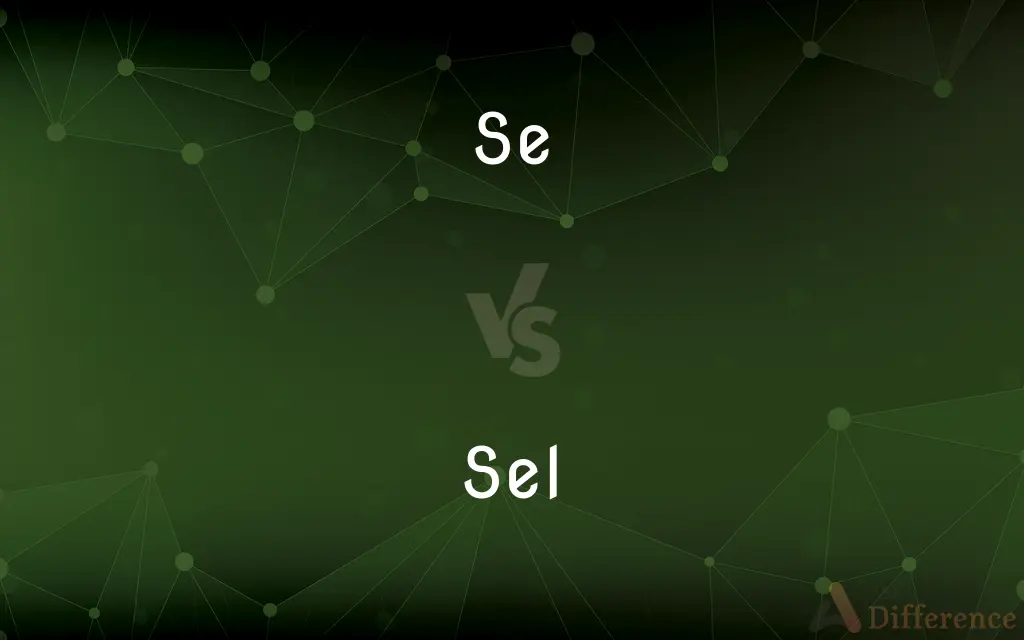Se vs. Sel — What's the Difference?
By Tayyaba Rehman & Maham Liaqat — Updated on March 8, 2024
"Se" is a reflexive pronoun in Romance languages, while "Sel" refers to salt in French and German.

Difference Between Se and Sel
Table of Contents
ADVERTISEMENT
Key Differences
In Romance languages such as Spanish, Italian, and Portuguese, "se" is used as a reflexive pronoun, denoting an action performed by and upon the subject itself. On the other hand, "Sel" is a noun in French and German, meaning "salt." In French, "sel" is used in culinary contexts and beyond, signifying the mineral that's essential for life and a common seasoning in food.
The use of "se" is primarily grammatical, serving a function within the structure of sentences in Romance languages. It's essential for conveying reflexive actions, and its usage is dictated by the rules of grammar in those languages. The use of "sel," however, is more lexical, pertaining to the vocabulary and involves the naming of a substance known and used universally.
While "se" is a part of speech that changes the meaning of verbs by making them reflexive, "sel" as a noun stands alone and carries its specific meaning without altering the grammatical structure of a sentence. The understanding of "se" requires knowledge of verb conjugations and reflexive structures in Romance languages, whereas "sel" is understood as a direct reference to salt, with its implications and uses in language and culture.
Despite these differences, both terms highlight the richness and diversity of language, illustrating how different linguistic systems use distinct words and structures to express actions, objects, and concepts. The contrast between "se" and "sel" underscores the importance of context and language in determining meaning and usage.
Comparison Chart
Language
Romance languages (Spanish, Italian, etc.)
French and German
ADVERTISEMENT
Part of Speech
Pronoun
Noun
Usage
Indicates reflexive actions
Refers to the mineral salt
Context
Grammatical, within sentence structures
Lexical, as part of vocabulary
Example Usage
"Se lava" (He/She washes himself/herself)
"Passer le sel, s'il vous plaît" (Please pass the salt)
Compare with Definitions
Se
Can be used to form passive reflexive constructions.
Se venden coches aquí translates to Cars are sold here.
Sel
Used symbolically or in expressions.
C'est le sel de la vie translates to It's the spice of life.
Se
Utilized in impersonal constructions.
Se dice que... means It is said that...
Sel
Appears in historical and cultural references.
Le sel était une forme de monnaie dans l'antiquité translates to Salt was a form of currency in ancient times.
Se
Part of pronominal verbs that change meaning when used reflexively.
Irse means to go away or to leave.
Sel
Refers to the seasoning and preservative.
Je vais acheter du sel pour la recette means I will buy salt for the recipe.
Se
Used to indicate that the subject performs an action on itself.
In Spanish, Ella se mira en el espejo means She looks at herself in the mirror.
Sel
Found in culinary and scientific contexts.
Le sel est essentiel à l'équilibre électrolytique means Salt is essential for electrolyte balance.
Se
Inclusive in expressing general actions.
Aquí se habla español means Spanish is spoken here.
Sel
Utilized in health and dietary discussions.
Réduire le sel peut diminuer le risque d'hypertension means Reducing salt can decrease the risk of hypertension.
Se
(musical instrument) A type of ancient Chinese plucked zither.
Sel
Sel is a municipality in Innlandet county, Norway. It is part of the traditional region of the Gudbrand Valley.
Se
A toxic nonmetallic element related to sulfur and tellurium; occurs in several allotropic forms; a stable gray metallike allotrope conducts electricity better in the light than in the dark and is used in photocells; occurs in sulfide ores (as pyrite)
Se
The compass point midway between south and east; at 135 degrees
Common Curiosities
What is the function of "se" in Romance languages?
"Se" is a reflexive pronoun used to indicate that the subject of the verb is also its object, involved in actions performed upon itself.
Can "sel" be used to refer to anything other than salt?
While "sel" primarily means salt in French and German, it can also appear in expressions and symbolic contexts beyond its literal meaning.
How do I use "se" correctly in a sentence?
"Se" is used with reflexive verbs, placed before the conjugated verb or attached to the infinitive form, depending on the sentence structure.
Is "sel" used in all French-speaking regions?
Yes, "sel" is the standard word for salt in all French-speaking regions, although regional dialects may have additional terms or expressions.
Are there any common mistakes to avoid when using "se"?
A common mistake is confusing reflexive verbs with similar non-reflexive forms, changing the meaning of the sentence. Understanding reflexive verb conjugations and their meanings is crucial.
What role does "se" play in passive voice constructions?
In Romance languages, "se" can be used to form passive constructions, especially in cases where the agent performing the action is not specified, making sentences more impersonal.
How is "se" taught to language learners unfamiliar with reflexive pronouns?
"Se" is typically taught through examples and practice that highlight its reflexive nature, often starting with simple daily routines and self-care actions to illustrate its use.
In what contexts might "sel" appear in German?
"Sel" might appear in historical, regional, or dialectical contexts in German, but "Salz" is the standard term for salt in contemporary German language.
Is "sel" used in any specific culinary traditions more prominently?
"Sel" is a fundamental ingredient across various culinary traditions, but it holds particular significance in French cuisine, known for its careful seasoning and flavor enhancement.
How does the usage of "se" vary among different Romance languages?
While "se" serves a similar reflexive function across Romance languages, its usage and placement within sentences can vary slightly due to differences in grammatical rules and sentence structure among these languages.
Can "sel" have different meanings in French slang or expressions?
Yes, in French slang and expressions, "sel" can have metaphorical meanings, such as adding zest or interest to life, similar to the phrase "the spice of life" in English.
Are there any common errors in distinguishing between "se" as a reflexive pronoun and other pronouns in Romance languages?
Common errors include confusing "se" with direct or indirect object pronouns, which can alter the meaning of the verb and the overall sentence structure.
In what other contexts might "sel" appear outside of cooking and food?
"Sel" can appear in scientific contexts related to chemistry and health, in expressions and idioms, and in historical references to its value and trade.
Does the use of "sel" in French cuisine influence its use in French language and culture?
Yes, the importance of "sel" in French cuisine can influence its presence in language and culture, often symbolizing quality, taste, and the art of living well.
What are the challenges in translating "se" into languages without reflexive pronouns?
Translating "se" into languages without reflexive pronouns can be challenging, as it may require rephrasing or adding words to convey the reflexive action accurately.
Share Your Discovery

Previous Comparison
Arbiter vs. Arbitrator
Next Comparison
Tawny vs. PortAuthor Spotlight
Written by
Tayyaba RehmanTayyaba Rehman is a distinguished writer, currently serving as a primary contributor to askdifference.com. As a researcher in semantics and etymology, Tayyaba's passion for the complexity of languages and their distinctions has found a perfect home on the platform. Tayyaba delves into the intricacies of language, distinguishing between commonly confused words and phrases, thereby providing clarity for readers worldwide.
Co-written by
Maham Liaqat













































